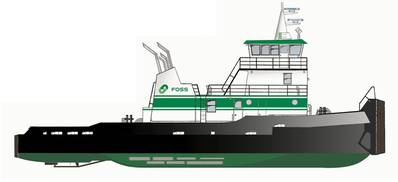King River Class by Foss & Cruz Marine
Vessel designed for hostile and remote environments incorporates what Foss has learned in nine decades of work in the Arctic
Foss Maritime and Cruz Marine LLC have partnered to launch the first of the King River class of tug: a shallow draft vessel designed specifically for remote, extreme environments like the north slope of Alaska, the Canadian Arctic and the Russian Far east.
Gary Faber, President and COO of Foss Maritime, said "When our customers talk to us about what they need in places like Alaska or the Russian Far East, we listen. That's why we reached out to Cruz Marine, another company with extensive knowledge of extreme environments. The Dana Cruz is our answer to the shallow-draft ports, the hazardous weather and the ice you encounter in spades working above the Arctic Circle."
Said Kevin Weiss, Director of Marine Operations at Cruz Marine, "Our two companies bring decades of local Alaska knowledge to the table. We appreciate our Foss partnership because we know the value Foss places on innovation. Just look at the challenges Foss overcame 200 miles above the Arctic Circle at the Red Dog Mine. The Dana Cruz is designed with those same challenges in mind."
The tug's features include:
• A working draft of between three feet nine inches and five feet nine inches;
• An hull arrangement and strength members to resist damages due to contact with ice;
• Holding tanks for sewage and oily water;
• Fuel tank separated from hull with voids for extra margin of safety;
• Electric deck and towing winches to eliminate the opportunity for a release of lubricants to the environment;
• Hospital grade engine silencers;
• An aqua-drive anti-vibration system; and,
• Infrared navigation.
The Dana Cruz is powered by three low-emission Caterpillar EPA Tier 2 engines. The tug was designed by AG McIlwain with an ABS Load Line and is 92 feet long and 36 feet wide. Built to work in remote, shallow draft environments, the Dana Cruz will be headed north to support the summer ice-free construction season in Western Alaska and the North Slope.













